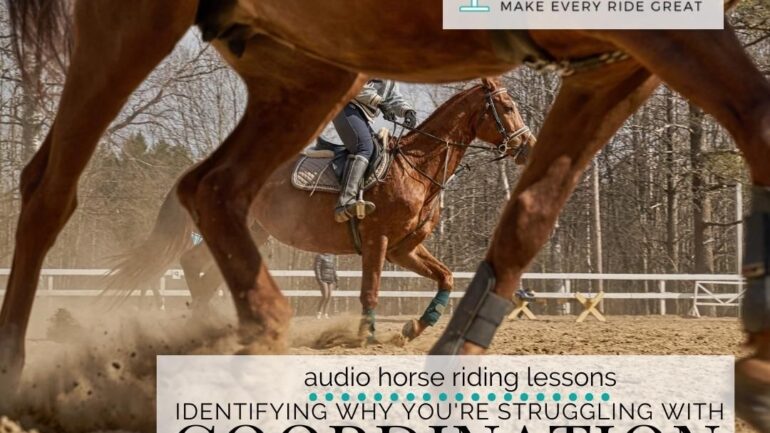Horse riding is essentially about how we can communicate with our horses – while riding our horses. However, as riders, in order to be effective we need to first master some basic coordination. And therein lies the challenge! It is often this part of communication, the one between our brains and our bodies, that can cause the greatest issues when it comes to our effectiveness when in the saddle.
Resulting in our lack of effective coordination creating havoc with our communication when riding our horse!
The lack of coordination really has a knock-on effect on all of the other parts of riding a horse. From our balance to our confidence. How we ask questions of our horses. And how we can respond when they answer. If any one of these elements is negatively impacted by poor coordination, it will cause challenges for both the rider – and their horse.
1. Identify the Trigger
This is a big part of beginning to successfully improve your coordination as a rider. In my experience, most riders are pretty okay with their coordination up to a certain point. And it is at that point (which is unique to every rider) that things tend to begin going a little (or a lot) off plan!
A trigger, for you, could be something physical, mental, or emotional. Meaning it could be a certain gait (like canter itself), a certain thought (I have to ask for canter), or a certain feeling (the fear of cantering).
The physical trigger shows up when your horse reaches a certain point with how much energy they are creating and using. Maybe a slow trot is fine, and you can still coordinate your aids effectively. However, as soon as there is more energy inside of that trot, oh the issues, they come knocking!
The mental and emotional triggers are often a little more challenging to identify, as it requires self-awareness regarding thoughts, beliefs, and feelings. However, they are just as disruptive to the overall flow of communication between you and your horse.
2. Notice What Coordination is Affected
Now, saying ‘I struggle with coordination’ is a little like saying ‘I struggle with confidence’ (something I hear so often from riders). It is just too open-ended and broad for anyone to give any real specific advice on how to improve coordination. By being more specific, you can start working on certain movements where you can practice and improve your skills.
Poor coordination can be knowing what you want to do, but not being able to do it. Or struggling to move one limb – without moving another. It can be shifting your weight to compensate for weak muscle tone or strength. Or even struggling to apply one aid without unintentionally doing something with another.
Just like the triggers, there are so many different types of a lack of coordination when it comes to your riding. Get really clear on what exactly or when exactly you struggle and start there.
3. Exercises to Help Strengthen & Improve
Once you know where the issue with your coordination lies, you can now easily begin to work on it. I am a big believer in creating situations where you get to ‘test’ yourself and practice the outcome you want. Think about this in your riding. What school moments can you ride that will require you to do something that you find a little challenging coordination-wise?
It’s also worth noting that physical strength, fitness, and stamina play a huge role in coordination. Even when the triggers are mental or emotional.
I would definitely advise you to do exercises outside of riding that will help you when you are in the saddle. I personally love hiking over rough terrain and yoga. They are both great for suppleness, stamina, strength, and overall fitness.
4. Revisit and Refine
Unfortunately, most riding issues are not a ‘fix one-time’ event! They will repeat themselves a lot. This is especially true when we ask new or bigger questions about ourselves or our horses in our riding. This is why, again, I really do believe setting these situations up for yourself intentionally is the most effective way of improving.
By intentionally putting ourselves in situations where our coordination may be questionable, we get to practice and become more effective.
This will also mean that when you find yourself being ‘tested’ unintentionally, there is a better chance of your body doing what you want and your horse understanding. This is exactly what we want in these situations. This can always be improved by revisiting and refining the basics of your riding.
Happy Riding
Lorna
Other Resources on This Topic:-
- The Link Between Responsiveness and Your Coordination
- Improving Rider Coordination
- How to Secure a Swinging Lower Leg
- Improving Your Effectiveness as a Rider
Training For Riders:-
- FREE Equestrian Fitness Challenge
- Returning to Riding
- Groundwork for Riding
- Free Online Community for the Daily Strides Podcast
- Free Online Community for Riders Working Alone without a Trainer or a Coach

